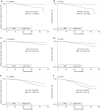T1a triple negative breast cancer has the worst prognosis among all the small tumor (<1 cm) of TNBC and HER2-rich subtypes
- PMID: 33842238
- PMCID: PMC8033067
- DOI: 10.21037/gs-20-762
T1a triple negative breast cancer has the worst prognosis among all the small tumor (<1 cm) of TNBC and HER2-rich subtypes
Abstract
Background: Triple negative breast cancer (TNBC), accounting for 15% of all breast cancer cases, was usually considered as the most aggressive subtype. The present study evaluated the prognosis of T1a TNBC and the impact of tumor size on T1 TNBC survival in large-scale population.
Methods: This retrospective study enrolled T1a/T1b/T1c TNBC and HER2+/hormone receptor (HoR)- patients diagnosed between 2010 to 2012 from the Surveillance, Epidemiology, and End Results database. The following information was extracted for further analyses: demographic variables including age at diagnosis, race, marital status, laterality, histological grade, T/N stage, American Joint Committee on Cancer (AJCC) stage, radiation therapy, survival and cause of death. Kaplan-Meier method and Cox regression were engaged for breast cancer specific survival (BCSS) and overall survival (OS) analyses.
Results: In all, the present study enrolled 6,953 TNBC and 2,648 HER2+/HoR- patients. T1a TNBC which generally omitted adjuvant chemotherapy had worse prognosis than T1a HER2+/HoR- [BCSS: hazard ratio (HR) 3.23, 95% confidence interval (CI): 1.05-9.09, P=0.03; OS: HR 2.63, 95% CI: 1.25-5.56, P=0.01] and T1b HER2+/HoR- (BCSS: HR 5.26, 95% CI: 1.61-16.7, P=0.006; OS: HR 3.03, 95% CI: 1.27-7.14, P=0.013) tumors which both were recommended by the National Comprehensive Cancer Network (NCCN) guideline to have chemotherapy. T1a TNBC also showed a trend with poorer prognosis than T1b TNBC, but did not reach statistical significance.
Conclusions: T1a TNBC had the worst prognosis among all small tumors (<1 cm) of TNBC and HER2+/HoR- subtypes, indicating the necessity of more intensive adjuvant treatment.
Keywords: T1a breast cancer; chemotherapy; survival; triple negative breast cancer (TNBC).
2021 Gland Surgery. All rights reserved.
Conflict of interest statement
Conflicts of Interest: All authors have completed the ICMJE uniform disclosure form (available at http://dx.doi.org/10.21037/gs-20-762). The authors have no conflicts of interest to declare.
Figures



Similar articles
-
Would 1.0 cm be a more suitable cutoff to subdivide pT1 tumors in hormone receptor-negative and HER2-positive breast cancer?Cancer Med. 2018 Nov;7(11):5420-5430. doi: 10.1002/cam4.1785. Epub 2018 Oct 1. Cancer Med. 2018. PMID: 30277006 Free PMC article.
-
Survival Outcome and Impact of Chemotherapy in T1 Node-Negative Triple-Negative Breast Cancer: A SEER Database Analysis.J Oncol. 2020 Dec 10;2020:8880727. doi: 10.1155/2020/8880727. eCollection 2020. J Oncol. 2020. PMID: 33381180 Free PMC article.
-
Benefit of adjuvant chemotherapy in lymph node-negative, T1b and T1c triple-negative breast cancer.Breast Cancer Res Treat. 2024 Jan;203(2):257-269. doi: 10.1007/s10549-023-07132-6. Epub 2023 Oct 13. Breast Cancer Res Treat. 2024. PMID: 37833449
-
Treatment of small (T1mic, T1a, and T1b) node-negative HER2+ breast cancer - a review of current evidence for and against the use of anti-HER2 treatment regimens.Expert Rev Anticancer Ther. 2022 May;22(5):505-522. doi: 10.1080/14737140.2022.2063844. Epub 2022 Apr 20. Expert Rev Anticancer Ther. 2022. PMID: 35389302 Free PMC article. Review.
-
Genomic profiling in triple-negative breast cancer.Breast Care (Basel). 2013 Dec;8(6):408-13. doi: 10.1159/000357534. Breast Care (Basel). 2013. PMID: 24550748 Free PMC article. Review.
Cited by
-
HER2-Positive Breast Cancer-Current Treatment Management and New Therapeutic Methods for Brain Metastasis.Biomedicines. 2025 May 9;13(5):1153. doi: 10.3390/biomedicines13051153. Biomedicines. 2025. PMID: 40426980 Free PMC article. Review.
-
Comparing CD10 Expression With the Clinicopathological Features and Hormone Status of Invasive Breast Cancer.Cureus. 2024 Sep 21;16(9):e69836. doi: 10.7759/cureus.69836. eCollection 2024 Sep. Cureus. 2024. PMID: 39435217 Free PMC article.
-
Crocin inhibit the metastasis of MDA-MB-231 cell line by suppressing epithelial to mesenchymal transition through WNT/β-catenin signalling pathway.Ann Med Surg (Lond). 2024 Jan 8;86(3):1401-1407. doi: 10.1097/MS9.0000000000001691. eCollection 2024 Mar. Ann Med Surg (Lond). 2024. PMID: 38463069 Free PMC article.
-
Tumor characteristics and survival rate of HER2-low breast cancer patients: a retrospective cohort study.Sci Rep. 2023 Oct 4;13(1):16719. doi: 10.1038/s41598-023-43186-8. Sci Rep. 2023. PMID: 37794050 Free PMC article.
-
From Trivial Trauma to Major Surgery: Navigating Skeletal Metastases with Sequential Hip Arthroplasty for Pathological Femoral Neck Fractures in Triple-Negative Breast Cancer.J Orthop Case Rep. 2025 Apr;15(4):121-125. doi: 10.13107/jocr.2025.v15.i04.5468. J Orthop Case Rep. 2025. PMID: 40212490 Free PMC article.
References
LinkOut - more resources
Full Text Sources
Other Literature Sources
Research Materials
Miscellaneous
